期末复习五大时态复习课课件2023-2024学年牛津译林版英语八年级上册(共33张PPT)
文档属性
| 名称 | 期末复习五大时态复习课课件2023-2024学年牛津译林版英语八年级上册(共33张PPT) |  | |
| 格式 | pptx | ||
| 文件大小 | 3.5MB | ||
| 资源类型 | 教案 | ||
| 版本资源 | 牛津译林版 | ||
| 科目 | 英语 | ||
| 更新时间 | 2023-12-23 12:56:26 | ||
图片预览

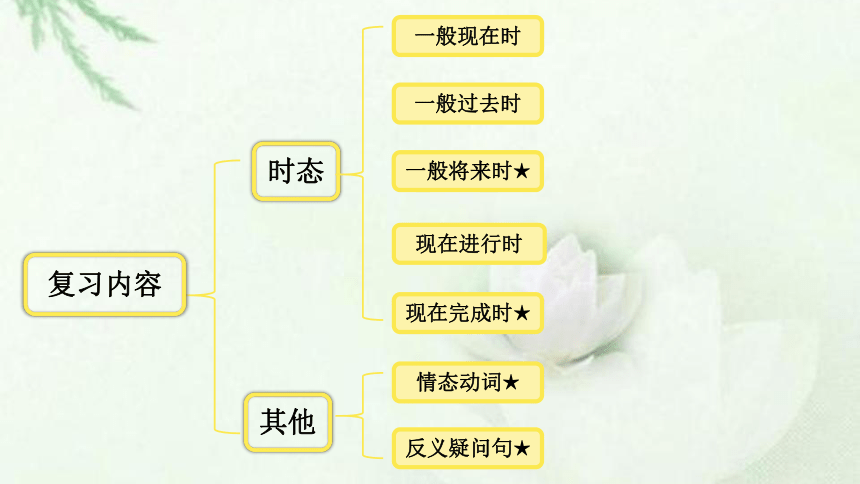
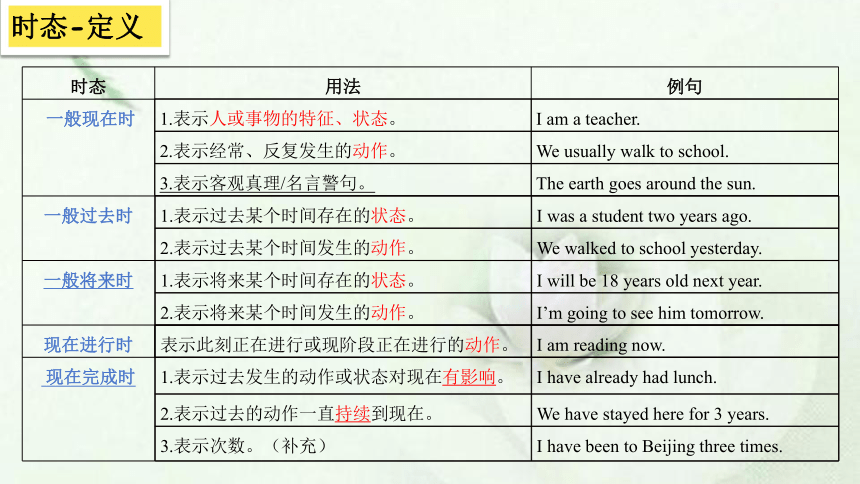
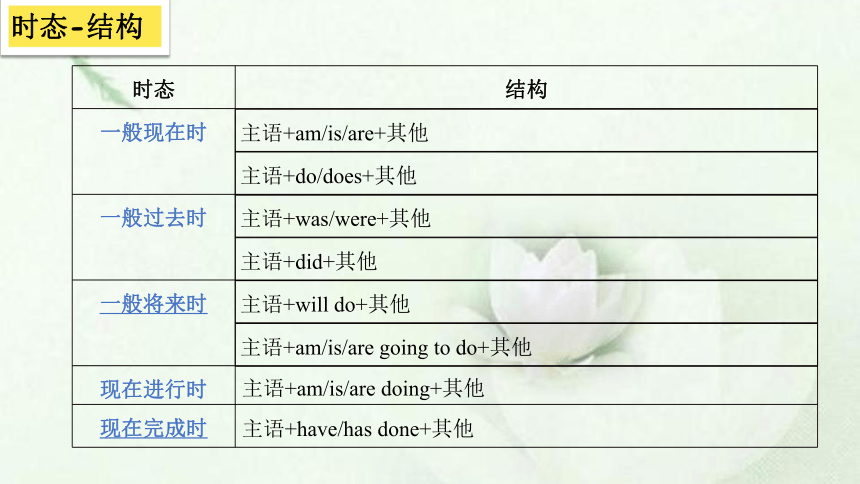
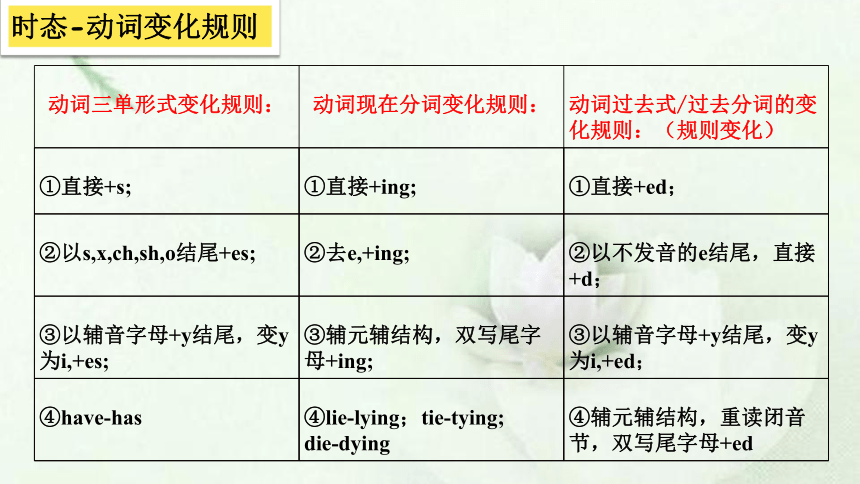
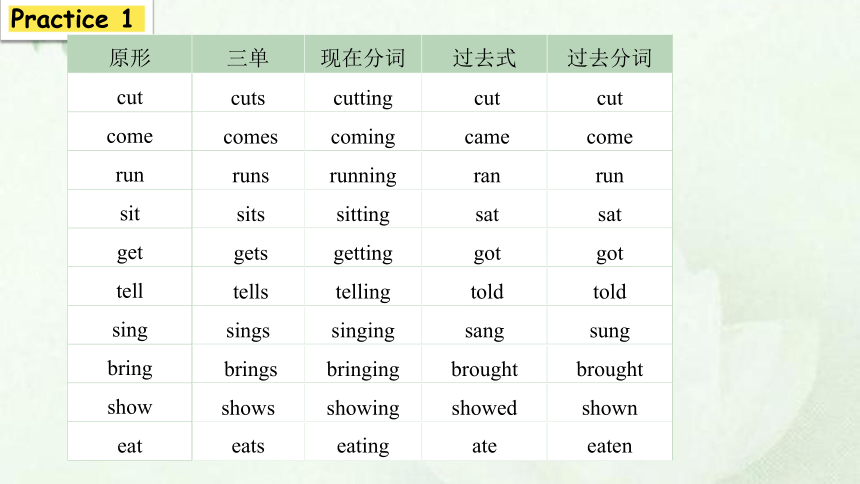
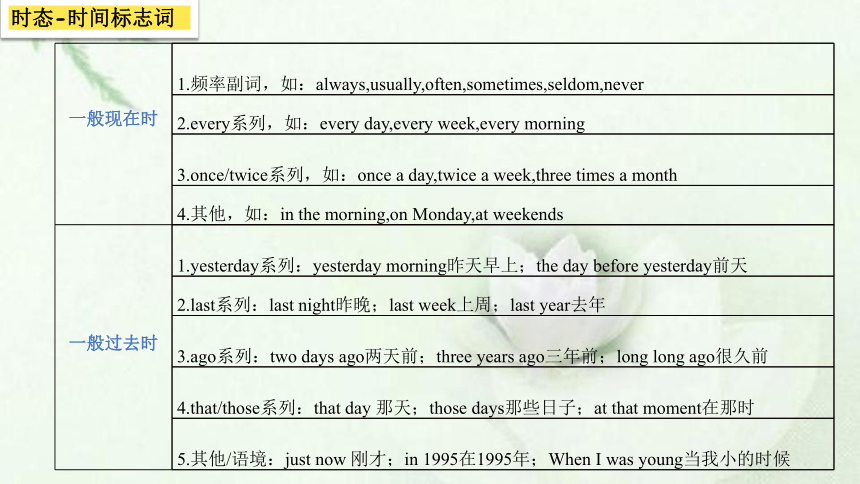
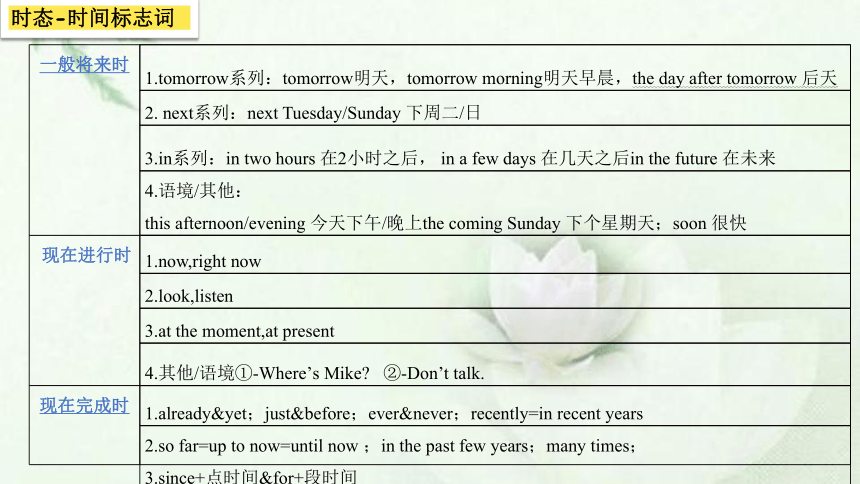
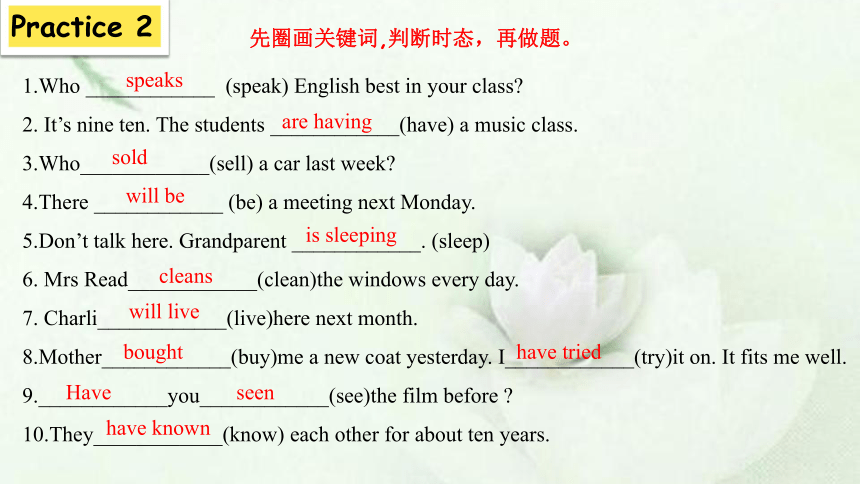
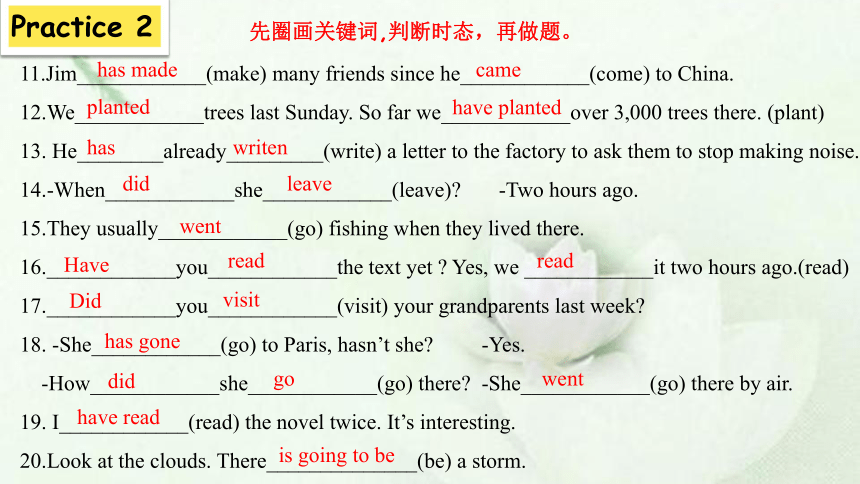
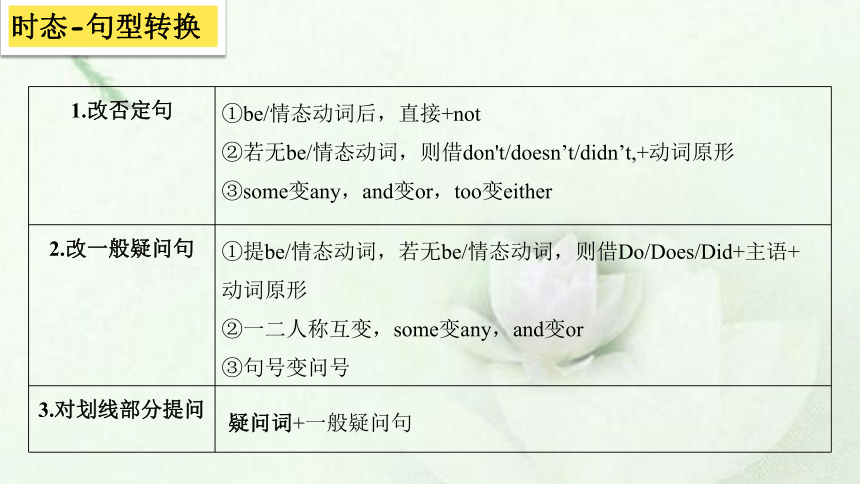
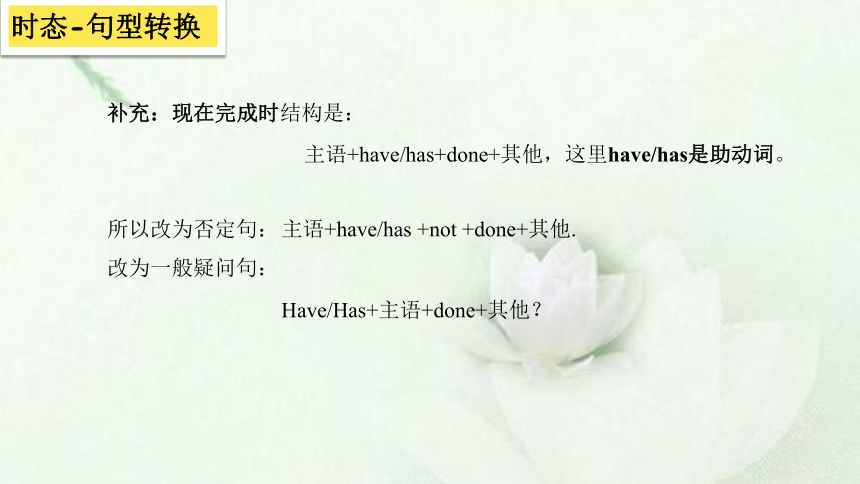
文档简介
(共33张PPT)
五大时态-复习课
时态
其他
复习内容
一般现在时
一般过去时
一般将来时★
现在进行时
情态动词★
反义疑问句★
现在完成时★
时态-定义
时态 用法 例句
一般现在时
一般过去时
一般将来时
现在进行时
现在完成时
1.表示人或事物的特征、状态。 I am a teacher.
2.表示经常、反复发生的动作。 We usually walk to school.
3.表示客观真理/名言警句。 The earth goes around the sun.
1.表示过去某个时间存在的状态。 I was a student two years ago.
2.表示过去某个时间发生的动作。 We walked to school yesterday.
1.表示将来某个时间存在的状态。 I will be 18 years old next year.
2.表示将来某个时间发生的动作。 I’m going to see him tomorrow.
1.表示过去发生的动作或状态对现在有影响。 I have already had lunch.
2.表示过去的动作一直持续到现在。 We have stayed here for 3 years.
3.表示次数。(补充) I have been to Beijing three times.
表示此刻正在进行或现阶段正在进行的动作。 I am reading now.
时态-结构
时态 结构
一般现在时
一般过去时
一般将来时
现在进行时
现在完成时
主语+am/is/are+其他
主语+do/does+其他
主语+was/were+其他
主语+did+其他
主语+will do+其他
主语+am/is/are going to do+其他
主语+am/is/are doing+其他
主语+have/has done+其他
时态-动词变化规则
动词三单形式变化规则: 动词现在分词变化规则:
动词过去式/过去分词的变化规则:(规则变化)
①直接+s;
②以s,x,ch,sh,o结尾+es;
③以辅音字母+y结尾,变y为i,+es;
④have-has
①直接+ing;
②去e,+ing;
③辅元辅结构,双写尾字母+ing;
④lie-lying;tie-tying;
die-dying
①直接+ed;
②以不发音的e结尾,直接+d;
③以辅音字母+y结尾,变y为i,+ed;
④辅元辅结构,重读闭音节,双写尾字母+ed
Practice 1
原形 三单 现在分词 过去式 过去分词
cut
come
run
sit
get
tell
sing
bring
show
eat
cuts cutting cut cut
comes coming came come
runs running ran run
sits sitting sat sat
gets getting got got
tells telling told told
sings singing sang sung
brings bringing brought brought
shows showing showed shown
eats eating ate eaten
时态-时间标志词
一般现在时
一般过去时
1.频率副词,如:always,usually,often,sometimes,seldom,never
2.every系列,如:every day,every week,every morning
3.once/twice系列,如:once a day,twice a week,three times a month
4.其他,如:in the morning,on Monday,at weekends
1.yesterday系列:yesterday morning昨天早上;the day before yesterday前天
2.last系列:last night昨晚;last week上周;last year去年
3.ago系列:two days ago两天前;three years ago三年前;long long ago很久前
4.that/those系列:that day 那天;those days那些日子;at that moment在那时
5.其他/语境:just now 刚才;in 1995在1995年;When I was young当我小的时候
时态-时间标志词
一般将来时
现在进行时
现在完成时
1.tomorrow系列:tomorrow明天,tomorrow morning明天早晨,the day after tomorrow 后天
2. next系列:next Tuesday/Sunday 下周二/日
3.in系列:in two hours 在2小时之后, in a few days 在几天之后in the future 在未来
4.语境/其他:
this afternoon/evening 今天下午/晚上the coming Sunday 下个星期天;soon 很快
1.now,right now
2.look,listen
3.at the moment,at present
4.其他/语境①-Where’s Mike ②-Don’t talk.
1.already&yet;just&before;ever&never;recently=in recent years
2.so far=up to now=until now ;in the past few years;many times;
3.since+点时间&for+段时间
Practice 2
1.Who ____________ (speak) English best in your class
2. It’s nine ten. The students ____________(have) a music class.
3.Who____________(sell) a car last week
4.There ____________ (be) a meeting next Monday.
5.Don’t talk here. Grandparent ____________. (sleep)
6. Mrs Read____________(clean)the windows every day.
7. Charli____________(live)here next month.
8.Mother____________(buy)me a new coat yesterday. I____________(try)it on. It fits me well.
9.____________you____________(see)the film before
10.They____________(know) each other for about ten years.
先圈画关键词,判断时态,再做题。
speaks
are having
sold
will be
is sleeping
cleans
will live
bought
have tried
Have
seen
have known
Practice 2
11.Jim____________(make) many friends since he____________(come) to China.
12.We____________trees last Sunday. So far we____________over 3,000 trees there. (plant)
13. He________already_________(write) a letter to the factory to ask them to stop making noise.
14.-When____________she____________(leave) -Two hours ago.
15.They usually____________(go) fishing when they lived there.
16.____________you____________the text yet Yes, we ____________it two hours ago.(read)
17.____________you____________(visit) your grandparents last week
18. -She____________(go) to Paris, hasn’t she -Yes.
-How____________she____________(go) there -She____________(go) there by air.
19. I____________(read) the novel twice. It’s interesting.
20.Look at the clouds. There______________(be) a storm.
has made
先圈画关键词,判断时态,再做题。
came
planted
have planted
has
writen
did
leave
went
Have
read
read
Did
visit
has gone
did
go
went
have read
is going to be
时态-句型转换
1.改否定句
2.改一般疑问句
3.对划线部分提问
①be/情态动词后,直接+not
②若无be/情态动词,则借don't/doesn’t/didn’t,+动词原形
③some变any,and变or,too变either
①提be/情态动词,若无be/情态动词,则借Do/Does/Did+主语+动词原形
②一二人称互变,some变any,and变or
③句号变问号
疑问词+一般疑问句
时态-句型转换
补充:现在完成时结构是:
所以改为否定句:
改为一般疑问句:
主语+have/has+done+其他,这里have/has是助动词。
主语+have/has +not +done+其他.
Have/Has+主语+done+其他?
Practice 3
1.Alice’s pencil box is on the table. __________________________________________________________________________________________________________________________
_____________________________________________________________
2.Alice did her homework last night.
_____________________________________________________________
__________________________________________________________________________________________________________________________
依次改为否定句,一般疑问句/肯否回答,以及对划线部分提问。
Alice’s pencil box isn’t on the table.
Is Alice’s pencil box on the table Yes,it is./No,it isn’t.
Whose pencil box is on the table
Alice didn’t do her homework last night.
Did Alice do her homework last night Yes,she did./No,she didn’t.
Who did her homework last night
Practice 3
3.They are going to Beijing next week. __________________________________________________________________________________________________________________________
_____________________________________________________________
4.Alice has already met her friend.
_____________________________________________________________
__________________________________________________________________________________________________________________________
依次改为否定句,一般疑问句/肯否回答,以及对划线部分提问。
They aren’t going to Beijing next week.
Are they going to Beijing next week Yes,they are./No,they aren’t.
Where are they going next week
Alice hasn’t met her friend yet.
Has Alice met her friend yet Yes,she has./No,she hasn’t.
Who has already met her friend
情态动词
情态动词是表示能力、请求、命令、猜测等说话人的语气或情态的动词。情态动词本身具有各种意义,但不能单独使用,只能和动词一起使用。
1.没有人称和数的变化。 ①I can sing. ②He can skate.
2.情态动词后面接动词原形。We must finish the homework.
3. 句式转换时,不需要借助动词。 She can’t ride a bike.
二、特点
一、定义
Practice 4
改错。
1. She coulds read that sentence. _____________ 2. He can’t at home. He has gone to Japan. _____________
3.You don’t must play with the knife or you may hurt yourself. _____________
4.Will you having dinner with me tonight _____________
5.You don’t should shout at him. _____________
could
can’t be
mustn’t
have
shouldn’t
情态动词
三、用法
分类 用法 例句
can
could
1.表示现在的能力,意为“能,会”。 She_________swim.
2.表示“请求,允许”。 __________I use this book
3.表示否定推测,意为“不可能”。 That _________Mr. Wang. He has gone to Beijing.
那不可能是王老师。他已经去北京了。
1.表示过去的能力,意为“能,会”,can-could(过去式)。 She__________swim when she was young.
2.表示“请求,允许”。更加委婉的语气,肯定回答时要改用can -Could I use your pen
______________________________
-Yes,you can./Of course you can.
can
Can
can’t be
could
情态动词
may
1.may用在疑问句中表示请求,意为“可以”。以may开头的一般疑问句,肯定回答用may或can,否定回答用can’t或mustn’t。 -May I use your fish pole
________________________________
2.表示推测,意为“也许,可能”。 Tomorrow I__________ go shopping.
3.表示祝愿,在正式场合或书面语中表示祝愿时,常放在句首。 May you have a good time!
祝你玩得愉快!
-Yes, you may/can./ No, you mustn’t.
may
情态动词
shall
should
在疑问句中,shall用来征询对方的意见或请求指示,多用于第一人称。 __________ we meet at 6 o’clock
1.表示建议,意为“应该”。 You ___________ read this book.
2.表示责任/义务,意为“应该”。 ①We___________study hard.
②We___________follow the traffic rules.
我们应该遵守交通规则。
Shall
should
should
should
情态动词
will
would
表示意愿,意为“愿意”。在疑问句中用于第二人称,表示询问对方的意愿或向对方提出请求。 ___________you close the window
表示“意愿”,意为“想要”。 (would like sth. /would like to do sth.) ①I would like to go with you tonight. ②-Would you like some apples
_________________________________
-Yes, I’d like to. /Yes,please./No,thanks.
Will
情态动词
must
have to
must表示主观“必须”,否定式must not/mustn’t表示“不准,禁止”。 ①He_________ finish his homework.
②You___________swim here,because it’s dangerous.
在回答must引导的一般疑问句时,否定回答要用needn’t或don’t have to。 -Must I be home before ten o’clock
________________________________
-No, you needn’t/don’t have to.
表客观必要,意为“不得不”。有多种形式,可用于不同时态。 ①Mother is out, so I ___________look after the shop.
②He__________go to work every day.
has to
must
mustn’t
have to
情态动词
need
need作情态动词,一般用于疑问句、否定句,意为“需要”。
①need + do;
②否定 needn’t + do;
③无人称、数的变化
④在回答need引导的一般疑问句时,肯定回答用must,否定回答用needn’t。
①I___________(go) now.
②You______________(go)now.
③She_____________(do)her homework.
④-Need you go now
——————————————
-Yes, I must. / No, I needn’t.
need作实义动词,意为“需要”。 (need sth./ need(sb.) to do sth.) ①I need some water.
②We need______________(work).
③She________________(not) know it.
doesn’t need to
need go
needn’t go
need do
to work
Practice 5
填入适当的情态动词。
can,could,may,shall,should,will would,must,have to,need
1.-Can you speak Japanese -No, I___________.
2.-He___________be in the classroom, I think.
-No, he___________be in the classroom. I saw him go home a minute ago.
3.You___________go and see a doctor because you had a fever.
4.-Mum,____________________I visit the Modern Art Museum next Monday
-I’m afraid you can’t.
5.-Hi, Jack! Could you come to our English party
-Sorry, I___________. I ___________ look after my little sister at home.
can’t
may
can’t
should
can/could/may
can’t
have to
Practice 5
填入适当的情态动词。
can,could,may,shall,should,will would,must,have to,need
6.-What’s wrong with Judy She has been absent for two days.
-Oh, she___________be ill. Let’s go to ask Mr. Green.
7.-Must I be home before ten o’clock
-No, you______________/ ______________.
8.Mike,you ______________finish your homework now.
9.You ______________ swim here,because it’s dangerous.
10.As a student, I ______________study very hard.
11.Mother is out, so I ______________look after the shop.
12. -Need you go now -Yes, I ______________. / No, I ______________.
may
needn’t don’t have to
must
mustn’t
must
have to
must needn’t
反义疑问句
1.前肯后否:She is nice,isn’t she 2.前否后肯:She can’t sing, can she
一、两大原则
二、反义疑问句的基本句型及特殊句型
1. 陈述句有be动词/情态动词时,以____________________构成反问;2. 陈述句有实义动词时,____________________构成反问;3. 祈使句(即以动词原形起首的句子)出现时,通常以_______________构成反问;4. 以Let’s起首的祈使句出现时,以_______________构成反问;
如果陈述部分为Let us……时,问句部分习惯上用_______________ 5. 陈述句有have/has时,判断好have/has是_______________还是_____________________,若是现在完成时里的助动词,则以______________构成反问;
该be动词/情态动词
借助动词do/does/did
will you
shall we
will you
实义动词
现在完成时里的助动词
该have/has
反义疑问句
6.当陈述部分的主语为指事(或物)的不定代词something、anything、everything等时,反意疑问部分的主语应用____________;7.当陈述部分的主语为指人的不定代词somebody、anybody 、everybody等时,反意疑问部分的主语可用_____________。
8.陈述句含有hardly, little, few,never, seldom,nobody,nothing等否定副词或短语时,该陈述句视为_______________,须接_______________反问。
9.反意疑问句的陈述部分含有由un-, im-, in-, dis-, 等否定意义的前缀构成的词语时,陈述部分要视为_______________,问句部分用________________形式。10.陈述部分是"there be"结构的,疑问部分用_______________。11.当陈述部分的主语为this,that等时,反意疑问部分的主语应用_____________。当陈述部分的主语为these,those等时,反意疑向部分的主语应用______________。
it
he或they
否定句
肯定
肯定含义
否定
there
it
they
三、反意疑问句的回答(根据事实回答)
回答反意疑问时,如果事实是肯定的,则用yes;若事实是否的,则用no。其回答方式与一般疑问句的回答方式完全一致。
反义疑问句
【典型例题】1.露西滑冰滑得非常好,是吗?是的,她滑得很好。______________________________________________________________
2.他们不喜欢这套房子,是吗?是的,他们不喜欢。______________________________________________________________
Lucy skates very well,doesn’t she Yes,she does.
They don’t like this house,do they No,they don’t.
( ) 1. They came here to have a meeting on time, _________
A. didn’t they B. did they C. don’t they D. do they
( ) 2. Tom will come here on time, _________
A. won’t he B. will he C. doesn’t he D. does he
( ) 3. –Kate didn’t go to school yesterday, did she
–_________, though she did not feel very well.
A. Yes, she did B. Yes, she didn’t C. No, she didn’t D. No, she did
( ) 4. There are no museums in our city, _________
A. aren’t there B. are there C. is there D. isn’t there
( ) 5. They have never seen the film, ________
A. haven’t they B. have they C. do they D. don’t they
Practice 6
单项选择。
( )6. Let’s help each other and learn from each other, _____
A. shall we B. will you C. don’t you D. do you
( )7. Jim has a beautiful toy, ___________
A. does he B. doesn’t he C. is he D. isn’t he
( )8.He’s read this book before, ______
A. hasn’t he B. doesn’t he C. isn’t he D. wasn’t he
( )9.-Let’s go for a walk, ______
- OK, I’m coming . Don’t forget to bring your camera, ______
A. will you; will you B. will you; shall we C. shall we; shall we D. shall we; will you
( )10.John had a short walk after lunch, ________?
A. did he B. didn't he C. had he D. hadn't he
Practice 6
( )11.-There’s little meat left in the fridge, ________
-________. I’ll get some on my way home.
A. is there, Yes B. isn’t there, Yes C. is there, No D. isn’t there, No
( )12.-Tom finished his homework, didn’t he
-__________, though he was ill yesterday.
A. No, he didn’t B. Yes, he did C. Yes, he does D. No, he doesn’t
( )13.Don't keep poison in the kitchen, _______
A. do you B. shall we C. will you D. don't you
( )14.- He’s never stolen anything before, _______ he
- ________. It’s his third time to be taken to the police station.
A. hasn’t; Yes B. has; No C. has; Yes D. is; No
( )15.-It’s her birthday tomorrow, ______ - Yes, let’s have a surprise party for her.
A. isn’t it B. isn’t she C. doesn’t it D. doesn’t she
Practice 6
Practice 7
翻译句子。
1.Helen已经去过南京三次了,不是吗?______________________________________________________________
2.Kate昨天没去上学,是吗?
______________________________________________________________
3.这不可能是Mike,他刚去教室了。______________________________________________________________
4.-我现在必须完成作业吗? -不,没必要。______________________________________________________________
5.-我能借一下你的橡皮吗? -是的,可以。______________________________________________________________
Helen has been to Nanjing three times,hasn’t she
Kate didn’t go to school,did she
This can’t be Mike,he has gone to the classroom.
-Must I finish my homework -No,you needn’t./No,you don’t have to.
-May/Can/Could I borrow your rubber -Yes,you can.
Practice 7
翻译句子。
6.你不准在这游泳,因为这是危险的。______________________________________________________________
7.我们现在需要去工作了。
______________________________________________________________
8.咱们去野营吧,好吗。______________________________________________________________
9.当Nancy小的时候,她会跳舞。______________________________________________________________
10.她得每天照顾她的外婆,是吗?______________________________________________________________
You mustn’t swim here,because it’s dangerous.
We need to work now.
Let’s go camping,shall we
Nancy could dance when she was young.
She has to look after her grandma every day,doesn’t she
Practice 8
再次梳理教案
考点一对一提问
五大时态-复习课
时态
其他
复习内容
一般现在时
一般过去时
一般将来时★
现在进行时
情态动词★
反义疑问句★
现在完成时★
时态-定义
时态 用法 例句
一般现在时
一般过去时
一般将来时
现在进行时
现在完成时
1.表示人或事物的特征、状态。 I am a teacher.
2.表示经常、反复发生的动作。 We usually walk to school.
3.表示客观真理/名言警句。 The earth goes around the sun.
1.表示过去某个时间存在的状态。 I was a student two years ago.
2.表示过去某个时间发生的动作。 We walked to school yesterday.
1.表示将来某个时间存在的状态。 I will be 18 years old next year.
2.表示将来某个时间发生的动作。 I’m going to see him tomorrow.
1.表示过去发生的动作或状态对现在有影响。 I have already had lunch.
2.表示过去的动作一直持续到现在。 We have stayed here for 3 years.
3.表示次数。(补充) I have been to Beijing three times.
表示此刻正在进行或现阶段正在进行的动作。 I am reading now.
时态-结构
时态 结构
一般现在时
一般过去时
一般将来时
现在进行时
现在完成时
主语+am/is/are+其他
主语+do/does+其他
主语+was/were+其他
主语+did+其他
主语+will do+其他
主语+am/is/are going to do+其他
主语+am/is/are doing+其他
主语+have/has done+其他
时态-动词变化规则
动词三单形式变化规则: 动词现在分词变化规则:
动词过去式/过去分词的变化规则:(规则变化)
①直接+s;
②以s,x,ch,sh,o结尾+es;
③以辅音字母+y结尾,变y为i,+es;
④have-has
①直接+ing;
②去e,+ing;
③辅元辅结构,双写尾字母+ing;
④lie-lying;tie-tying;
die-dying
①直接+ed;
②以不发音的e结尾,直接+d;
③以辅音字母+y结尾,变y为i,+ed;
④辅元辅结构,重读闭音节,双写尾字母+ed
Practice 1
原形 三单 现在分词 过去式 过去分词
cut
come
run
sit
get
tell
sing
bring
show
eat
cuts cutting cut cut
comes coming came come
runs running ran run
sits sitting sat sat
gets getting got got
tells telling told told
sings singing sang sung
brings bringing brought brought
shows showing showed shown
eats eating ate eaten
时态-时间标志词
一般现在时
一般过去时
1.频率副词,如:always,usually,often,sometimes,seldom,never
2.every系列,如:every day,every week,every morning
3.once/twice系列,如:once a day,twice a week,three times a month
4.其他,如:in the morning,on Monday,at weekends
1.yesterday系列:yesterday morning昨天早上;the day before yesterday前天
2.last系列:last night昨晚;last week上周;last year去年
3.ago系列:two days ago两天前;three years ago三年前;long long ago很久前
4.that/those系列:that day 那天;those days那些日子;at that moment在那时
5.其他/语境:just now 刚才;in 1995在1995年;When I was young当我小的时候
时态-时间标志词
一般将来时
现在进行时
现在完成时
1.tomorrow系列:tomorrow明天,tomorrow morning明天早晨,the day after tomorrow 后天
2. next系列:next Tuesday/Sunday 下周二/日
3.in系列:in two hours 在2小时之后, in a few days 在几天之后in the future 在未来
4.语境/其他:
this afternoon/evening 今天下午/晚上the coming Sunday 下个星期天;soon 很快
1.now,right now
2.look,listen
3.at the moment,at present
4.其他/语境①-Where’s Mike ②-Don’t talk.
1.already&yet;just&before;ever&never;recently=in recent years
2.so far=up to now=until now ;in the past few years;many times;
3.since+点时间&for+段时间
Practice 2
1.Who ____________ (speak) English best in your class
2. It’s nine ten. The students ____________(have) a music class.
3.Who____________(sell) a car last week
4.There ____________ (be) a meeting next Monday.
5.Don’t talk here. Grandparent ____________. (sleep)
6. Mrs Read____________(clean)the windows every day.
7. Charli____________(live)here next month.
8.Mother____________(buy)me a new coat yesterday. I____________(try)it on. It fits me well.
9.____________you____________(see)the film before
10.They____________(know) each other for about ten years.
先圈画关键词,判断时态,再做题。
speaks
are having
sold
will be
is sleeping
cleans
will live
bought
have tried
Have
seen
have known
Practice 2
11.Jim____________(make) many friends since he____________(come) to China.
12.We____________trees last Sunday. So far we____________over 3,000 trees there. (plant)
13. He________already_________(write) a letter to the factory to ask them to stop making noise.
14.-When____________she____________(leave) -Two hours ago.
15.They usually____________(go) fishing when they lived there.
16.____________you____________the text yet Yes, we ____________it two hours ago.(read)
17.____________you____________(visit) your grandparents last week
18. -She____________(go) to Paris, hasn’t she -Yes.
-How____________she____________(go) there -She____________(go) there by air.
19. I____________(read) the novel twice. It’s interesting.
20.Look at the clouds. There______________(be) a storm.
has made
先圈画关键词,判断时态,再做题。
came
planted
have planted
has
writen
did
leave
went
Have
read
read
Did
visit
has gone
did
go
went
have read
is going to be
时态-句型转换
1.改否定句
2.改一般疑问句
3.对划线部分提问
①be/情态动词后,直接+not
②若无be/情态动词,则借don't/doesn’t/didn’t,+动词原形
③some变any,and变or,too变either
①提be/情态动词,若无be/情态动词,则借Do/Does/Did+主语+动词原形
②一二人称互变,some变any,and变or
③句号变问号
疑问词+一般疑问句
时态-句型转换
补充:现在完成时结构是:
所以改为否定句:
改为一般疑问句:
主语+have/has+done+其他,这里have/has是助动词。
主语+have/has +not +done+其他.
Have/Has+主语+done+其他?
Practice 3
1.Alice’s pencil box is on the table. __________________________________________________________________________________________________________________________
_____________________________________________________________
2.Alice did her homework last night.
_____________________________________________________________
__________________________________________________________________________________________________________________________
依次改为否定句,一般疑问句/肯否回答,以及对划线部分提问。
Alice’s pencil box isn’t on the table.
Is Alice’s pencil box on the table Yes,it is./No,it isn’t.
Whose pencil box is on the table
Alice didn’t do her homework last night.
Did Alice do her homework last night Yes,she did./No,she didn’t.
Who did her homework last night
Practice 3
3.They are going to Beijing next week. __________________________________________________________________________________________________________________________
_____________________________________________________________
4.Alice has already met her friend.
_____________________________________________________________
__________________________________________________________________________________________________________________________
依次改为否定句,一般疑问句/肯否回答,以及对划线部分提问。
They aren’t going to Beijing next week.
Are they going to Beijing next week Yes,they are./No,they aren’t.
Where are they going next week
Alice hasn’t met her friend yet.
Has Alice met her friend yet Yes,she has./No,she hasn’t.
Who has already met her friend
情态动词
情态动词是表示能力、请求、命令、猜测等说话人的语气或情态的动词。情态动词本身具有各种意义,但不能单独使用,只能和动词一起使用。
1.没有人称和数的变化。 ①I can sing. ②He can skate.
2.情态动词后面接动词原形。We must finish the homework.
3. 句式转换时,不需要借助动词。 She can’t ride a bike.
二、特点
一、定义
Practice 4
改错。
1. She coulds read that sentence. _____________ 2. He can’t at home. He has gone to Japan. _____________
3.You don’t must play with the knife or you may hurt yourself. _____________
4.Will you having dinner with me tonight _____________
5.You don’t should shout at him. _____________
could
can’t be
mustn’t
have
shouldn’t
情态动词
三、用法
分类 用法 例句
can
could
1.表示现在的能力,意为“能,会”。 She_________swim.
2.表示“请求,允许”。 __________I use this book
3.表示否定推测,意为“不可能”。 That _________Mr. Wang. He has gone to Beijing.
那不可能是王老师。他已经去北京了。
1.表示过去的能力,意为“能,会”,can-could(过去式)。 She__________swim when she was young.
2.表示“请求,允许”。更加委婉的语气,肯定回答时要改用can -Could I use your pen
______________________________
-Yes,you can./Of course you can.
can
Can
can’t be
could
情态动词
may
1.may用在疑问句中表示请求,意为“可以”。以may开头的一般疑问句,肯定回答用may或can,否定回答用can’t或mustn’t。 -May I use your fish pole
________________________________
2.表示推测,意为“也许,可能”。 Tomorrow I__________ go shopping.
3.表示祝愿,在正式场合或书面语中表示祝愿时,常放在句首。 May you have a good time!
祝你玩得愉快!
-Yes, you may/can./ No, you mustn’t.
may
情态动词
shall
should
在疑问句中,shall用来征询对方的意见或请求指示,多用于第一人称。 __________ we meet at 6 o’clock
1.表示建议,意为“应该”。 You ___________ read this book.
2.表示责任/义务,意为“应该”。 ①We___________study hard.
②We___________follow the traffic rules.
我们应该遵守交通规则。
Shall
should
should
should
情态动词
will
would
表示意愿,意为“愿意”。在疑问句中用于第二人称,表示询问对方的意愿或向对方提出请求。 ___________you close the window
表示“意愿”,意为“想要”。 (would like sth. /would like to do sth.) ①I would like to go with you tonight. ②-Would you like some apples
_________________________________
-Yes, I’d like to. /Yes,please./No,thanks.
Will
情态动词
must
have to
must表示主观“必须”,否定式must not/mustn’t表示“不准,禁止”。 ①He_________ finish his homework.
②You___________swim here,because it’s dangerous.
在回答must引导的一般疑问句时,否定回答要用needn’t或don’t have to。 -Must I be home before ten o’clock
________________________________
-No, you needn’t/don’t have to.
表客观必要,意为“不得不”。有多种形式,可用于不同时态。 ①Mother is out, so I ___________look after the shop.
②He__________go to work every day.
has to
must
mustn’t
have to
情态动词
need
need作情态动词,一般用于疑问句、否定句,意为“需要”。
①need + do;
②否定 needn’t + do;
③无人称、数的变化
④在回答need引导的一般疑问句时,肯定回答用must,否定回答用needn’t。
①I___________(go) now.
②You______________(go)now.
③She_____________(do)her homework.
④-Need you go now
——————————————
-Yes, I must. / No, I needn’t.
need作实义动词,意为“需要”。 (need sth./ need(sb.) to do sth.) ①I need some water.
②We need______________(work).
③She________________(not) know it.
doesn’t need to
need go
needn’t go
need do
to work
Practice 5
填入适当的情态动词。
can,could,may,shall,should,will would,must,have to,need
1.-Can you speak Japanese -No, I___________.
2.-He___________be in the classroom, I think.
-No, he___________be in the classroom. I saw him go home a minute ago.
3.You___________go and see a doctor because you had a fever.
4.-Mum,____________________I visit the Modern Art Museum next Monday
-I’m afraid you can’t.
5.-Hi, Jack! Could you come to our English party
-Sorry, I___________. I ___________ look after my little sister at home.
can’t
may
can’t
should
can/could/may
can’t
have to
Practice 5
填入适当的情态动词。
can,could,may,shall,should,will would,must,have to,need
6.-What’s wrong with Judy She has been absent for two days.
-Oh, she___________be ill. Let’s go to ask Mr. Green.
7.-Must I be home before ten o’clock
-No, you______________/ ______________.
8.Mike,you ______________finish your homework now.
9.You ______________ swim here,because it’s dangerous.
10.As a student, I ______________study very hard.
11.Mother is out, so I ______________look after the shop.
12. -Need you go now -Yes, I ______________. / No, I ______________.
may
needn’t don’t have to
must
mustn’t
must
have to
must needn’t
反义疑问句
1.前肯后否:She is nice,isn’t she 2.前否后肯:She can’t sing, can she
一、两大原则
二、反义疑问句的基本句型及特殊句型
1. 陈述句有be动词/情态动词时,以____________________构成反问;2. 陈述句有实义动词时,____________________构成反问;3. 祈使句(即以动词原形起首的句子)出现时,通常以_______________构成反问;4. 以Let’s起首的祈使句出现时,以_______________构成反问;
如果陈述部分为Let us……时,问句部分习惯上用_______________ 5. 陈述句有have/has时,判断好have/has是_______________还是_____________________,若是现在完成时里的助动词,则以______________构成反问;
该be动词/情态动词
借助动词do/does/did
will you
shall we
will you
实义动词
现在完成时里的助动词
该have/has
反义疑问句
6.当陈述部分的主语为指事(或物)的不定代词something、anything、everything等时,反意疑问部分的主语应用____________;7.当陈述部分的主语为指人的不定代词somebody、anybody 、everybody等时,反意疑问部分的主语可用_____________。
8.陈述句含有hardly, little, few,never, seldom,nobody,nothing等否定副词或短语时,该陈述句视为_______________,须接_______________反问。
9.反意疑问句的陈述部分含有由un-, im-, in-, dis-, 等否定意义的前缀构成的词语时,陈述部分要视为_______________,问句部分用________________形式。10.陈述部分是"there be"结构的,疑问部分用_______________。11.当陈述部分的主语为this,that等时,反意疑问部分的主语应用_____________。当陈述部分的主语为these,those等时,反意疑向部分的主语应用______________。
it
he或they
否定句
肯定
肯定含义
否定
there
it
they
三、反意疑问句的回答(根据事实回答)
回答反意疑问时,如果事实是肯定的,则用yes;若事实是否的,则用no。其回答方式与一般疑问句的回答方式完全一致。
反义疑问句
【典型例题】1.露西滑冰滑得非常好,是吗?是的,她滑得很好。______________________________________________________________
2.他们不喜欢这套房子,是吗?是的,他们不喜欢。______________________________________________________________
Lucy skates very well,doesn’t she Yes,she does.
They don’t like this house,do they No,they don’t.
( ) 1. They came here to have a meeting on time, _________
A. didn’t they B. did they C. don’t they D. do they
( ) 2. Tom will come here on time, _________
A. won’t he B. will he C. doesn’t he D. does he
( ) 3. –Kate didn’t go to school yesterday, did she
–_________, though she did not feel very well.
A. Yes, she did B. Yes, she didn’t C. No, she didn’t D. No, she did
( ) 4. There are no museums in our city, _________
A. aren’t there B. are there C. is there D. isn’t there
( ) 5. They have never seen the film, ________
A. haven’t they B. have they C. do they D. don’t they
Practice 6
单项选择。
( )6. Let’s help each other and learn from each other, _____
A. shall we B. will you C. don’t you D. do you
( )7. Jim has a beautiful toy, ___________
A. does he B. doesn’t he C. is he D. isn’t he
( )8.He’s read this book before, ______
A. hasn’t he B. doesn’t he C. isn’t he D. wasn’t he
( )9.-Let’s go for a walk, ______
- OK, I’m coming . Don’t forget to bring your camera, ______
A. will you; will you B. will you; shall we C. shall we; shall we D. shall we; will you
( )10.John had a short walk after lunch, ________?
A. did he B. didn't he C. had he D. hadn't he
Practice 6
( )11.-There’s little meat left in the fridge, ________
-________. I’ll get some on my way home.
A. is there, Yes B. isn’t there, Yes C. is there, No D. isn’t there, No
( )12.-Tom finished his homework, didn’t he
-__________, though he was ill yesterday.
A. No, he didn’t B. Yes, he did C. Yes, he does D. No, he doesn’t
( )13.Don't keep poison in the kitchen, _______
A. do you B. shall we C. will you D. don't you
( )14.- He’s never stolen anything before, _______ he
- ________. It’s his third time to be taken to the police station.
A. hasn’t; Yes B. has; No C. has; Yes D. is; No
( )15.-It’s her birthday tomorrow, ______ - Yes, let’s have a surprise party for her.
A. isn’t it B. isn’t she C. doesn’t it D. doesn’t she
Practice 6
Practice 7
翻译句子。
1.Helen已经去过南京三次了,不是吗?______________________________________________________________
2.Kate昨天没去上学,是吗?
______________________________________________________________
3.这不可能是Mike,他刚去教室了。______________________________________________________________
4.-我现在必须完成作业吗? -不,没必要。______________________________________________________________
5.-我能借一下你的橡皮吗? -是的,可以。______________________________________________________________
Helen has been to Nanjing three times,hasn’t she
Kate didn’t go to school,did she
This can’t be Mike,he has gone to the classroom.
-Must I finish my homework -No,you needn’t./No,you don’t have to.
-May/Can/Could I borrow your rubber -Yes,you can.
Practice 7
翻译句子。
6.你不准在这游泳,因为这是危险的。______________________________________________________________
7.我们现在需要去工作了。
______________________________________________________________
8.咱们去野营吧,好吗。______________________________________________________________
9.当Nancy小的时候,她会跳舞。______________________________________________________________
10.她得每天照顾她的外婆,是吗?______________________________________________________________
You mustn’t swim here,because it’s dangerous.
We need to work now.
Let’s go camping,shall we
Nancy could dance when she was young.
She has to look after her grandma every day,doesn’t she
Practice 8
再次梳理教案
考点一对一提问
同课章节目录
